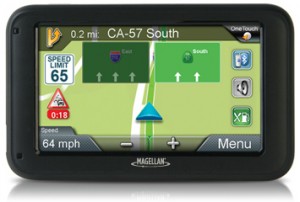For several years now, we’ve been using the Garmin Nuvi 1350 LMT GPS navigator, but read a sterling review of the Magellan RoadMate 5265T-LMB, which seemed to be for us, an upgrade. Perhaps its most notable feature was its ability to show points of interest on the actual display itself, so we could make turns based on easy-to-identify gas stations, stores, etc., so we wouldn’t have to hunt for street signs. Its 5 inch display was bigger, too, so we ordered one. Here’s how it stacks up with the Garmin.
The Magellan’s display isn’t lit as well as Garmin’s, so it’s more difficult to see when sunlight hits the screen. Although Garmin’s screen is smaller, Garmin makes better use of the screen. Garmin allows us to show current direction, current speed, elevation, and time simultaneously, right next to the map, whereas Magellan allows you to see only one of those elements on-screen at a time. You can touch the Magellan screen to get any of these elements individually, but it’s cumbersome to do so while driving, and must be done by reading small print, rather than by an icon.
A disadvantage of the Garmin is that you have to toggle through four screens to find points of interest, like gas stations and ATMs, meaning you really have to pull over, unless you have a co-pilot. That gets you a street address, but you must go through an additional two screens to actually get a map that will guide you there. The Magellan, allows you to program them in on the map, which is the advantage of having a larger screen.
The Magellan has the added advantage of having traffic warnings on-screen, and picked one up right around the corner from us the first time we used it. The Garmin also has traffic warnings, but to enable that feature, you must accept on-screen advertising. The Magellan features Red Light and Fixed Speed camera alerts, the Garmin does not. If you drive in an urban environment, this feature alone could save you the price you paid for the Magellan unit.
Both the Garmin and the Magellan include free lifetime maps, but with the Garmin, you must register the product online within 60 days or you lose the free lifetime map feature. The Garmin comes pre-loaded with maps for the lower 48 states, Hawaii and Puerto Rico. The Magellan includes all that, and Alaska as well. The Garmin unit has world map capability via a separate purchase of its WorldMap CD. We here at WoWasis have used the WorldMap in Asia, and have found it to be virtually worthless in Southeast Asian countries. We’ve not yet tested it in Europe. Based on Magellan’s website, it appears that international maps are not available for the 5265T-LMB unit.
In terms of pricing, the Garmin unit can be found on the web for $135 USD and the Magellan unit for $170 USD.
Which unit is best for you? The Magellan’s larger screen and on-screen points of interest are a plus, but sunlight creates a problem. The Garmin has an easy-to read screen with speed, time, direction, and distance on-screen, but points of interest are not resident on the screen, and require several clicks. Travelers to European countries may find benefit in the Garmin’s capability to download international maps. If you have a Blue Tooth mobile phone, the Magellan interfaces with it, the Garmin doesn’t. Overall, the Magellan has more bells & whistles, but again, if the sun hits the screen and you have the audio turned off or can’t hear it, then the unit doesn’t do much good. We’ll continue using both, but for our money, the Garmin’s a better value, considering its price point.
Buy the Garmin Nuvi 1350 LMT here at the WoWasis eStore.

Leave a Reply